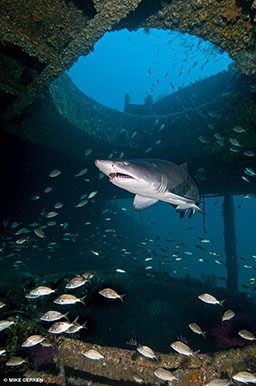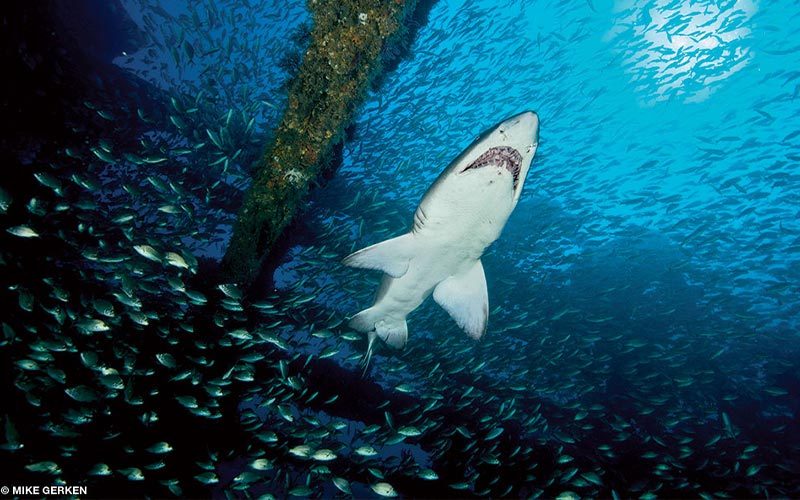While most humans try to avoid sharks, the surge in popularity of shark diving in the past 10 years shows that divers are enthusiastically traveling the world intentionally seeking them out.
North Carolina’s Outer Banks are a prime location for diving with sharks. Over the centuries, many ships met their demise there due to war, weather or human error as well as by becoming artificial reefs. These wrecks have morphed into prolific reef communities with abundant marine life from every link in the food chain, and sharks are the dominant predators.
Drawn in by the bountiful food supply, numerous species — including blacktip, sandbar, bull and occasionally hammerhead sharks — can be found on these wrecks. But the stars of the show are the plentiful sand tiger sharks (Carcharias taurus).
With small, piercing eyes that seem to stare at you from every direction and rows of ragged teeth protruding from a cruel smile, the sand tiger’s visage is reminiscent of a Hollywood villain’s. But looks can be deceiving; these sharks are actually docile and sedate animals that do not startle easily. Careful divers who respect the animals’ space will be able to achieve proximity without needing bait or chum. Because of the sharks’ mild disposition and the ease of finding them, encounters are almost guaranteed.
Geography plays an important role in producing the great diving opportunities off the North Carolina coast. The Gulf Stream heads north along the Western Atlantic, eventually colliding with the barrier beaches that are the Outer Banks. In the summer water temperatures can reach 80°F, with the average on the bottom hovering in the mid-70s°F. Visibility can exceed 100 feet on a good day, and the norm is around 60 feet. The combination of warm, clear water, historic wrecks and plentiful sharks and other marine life makes for world-class diving.
Even after spending hundreds of hours in the water with sand tigers, I still get a rush from being among these menacing-looking but gentle sharks. On a given dive only a handful may be on a wreck, while on another there may be too many to count. Each year in mid-July on the wreck of the Caribsea, east of Cape Lookout, sand tigers ascend from the bottom higher into the water column, where the water is clearer and warmer. On more than one occasion I have seen nearly 75 sharks, all females, gently swimming into the current in a schooling formation. It is unknown why they do this, but the sight of it is permanently etched in my mental logbook.

The aggregation of sand tigers on the wrecks is most likely due to the reliable source of food the shipwrecks provide. The wrecks may also serve as navigational aids during the sharks’ migrations. Dean Fessler, educational director of the Shark Research Institute, explained it this way: “Sand tigers migrate long distances up and down the East Coast, heading as far north as Maine in the summer and south to central Florida in the winter. They detect the electromagnetic fields the wrecks emit and use them as waypoints along their route, much like we would use a GPS.”
Whatever inclinations sand tigers have for the wrecks, recreational divers are happy they have them. Being surrounded by a plethora of toothy sharks while exploring a historic shipwreck makes the diving experience all the more fascinating and educational. As Fessler added, “It’s a history and biology lesson all in one.”
Also known as ragged-tooth sharks or gray nurse sharks, sand tigers are found worldwide, predominantly in temperate and subtropical waters, including the Atlantic coasts of North and South America as well as South Africa, Australia and Japan. Juvenile sand tigers are around 3 feet long at birth; the average length for adult males is 8 feet, while females max out at around 10 feet and 350 pounds.
Sand tigers tend to mate in late winter to early spring. The male shark will bite the female on the pectoral fin to latch on during the mating process. Each year in May, at the beginning of the dive season in North Carolina, many females are seen sporting grizzly wounds. But the sharks are fast healers. Come July the wounds are mostly healed with only faint scars remaining.
Every two or three years, after a gestation period of eight to 12 months, females typically give birth to one or two pups, typically one from each of her two uteri. These young sharks are frequently seen on the wrecks and are easy to approach. This small number of births is due to the fascinating but macabre phenomenon of intrauterine cannibalism, in which the larger and stronger fetuses consume the lesser ones. A pregnant female may start off with as many as 40 embryos but give birth to just the one or two pups. Hence, sand tiger sharks obtain their hunting instincts even before birth. The disadvantage of this is that sand tigers have one of the slowest rates of reproduction of any shark species. When their numbers are down it takes longer for them to rebound.
Overfishing of sand tigers has caused their numbers to plummet worldwide. In the 1970s and ’80s in Australia, divers purportedly used explosive powerheads to kill sharks for sport. Because of how easy it is to approach sand tigers, little skill was involved in this style of fishing, and the results were devastating. In the United States, recreational fishermen as well as commercial longliners and purse seiners often caught sand tigers unintentionally. Considered a “trash fish,” sand tigers caught as bycatch usually died. These and other unchecked and destructive fishing practices took a toll on sand tiger shark numbers to the point that they became a protected species in Australia, South Africa and the United States in 1997. Today they are listed as vulnerable on the International Union for Conservation of Nature and Natural Resources (IUCN) Red List of Threatened Species.
The answer to whether sand tiger numbers are increasing depends on who you ask. “I do not have any scientific evidence, but I do believe sand tiger shark populations might be on an upward trend,” said Chris Paparo, manager of the Marine Sciences Center at the Southampton campus of Stony Brook University. “In recent years, anglers targeting fluke or striped bass have been catching both adult and juvenile sand tiger sharks with greater frequency.”

Recreational divers who have been diving North Carolina’s wrecks for more than 25 years also report seeing more sand tiger sharks now then ever before. “Shark numbers may be stabilizing, but to say they are increasing may be a stretch,” Fessler countered. “There are more eyes in the water today looking for sharks than there were 25 years ago; in turn more sharks are being seen.”
Based on what I have witnessed over the past 15 years, I believe shark numbers are slowly on the rise. I’m seeing sharks on wrecks where they were rarely seen before and with more regularity. Regardless of whether their numbers are increasing or not, sand tiger sharks, like all marine apex predators, require continued protection. The health of the ocean ecosystem, on which we are dependent for fish stocks, starts at the top of the food chain. Abundant sharks equates to abundant marine life. It’s no coincidence that when we see the greatest numbers of sharks on wrecks we also see large gatherings of other fish such as Atlantic spadefish, grouper, jacks and flounder.
When I was a dive boat captain in North Carolina, each morning before departure I would ask the divers where they wanted to go. Most would say without hesitation, “We want sharks!” There was no need to twist my arm; a few minutes later we would be under way to wherever the hot spot for sand tigers was at the time. The wrecks of the Caribsea, Proteus, Atlas, Aeolus, USCGC Spar and W.E. Hutton (also known as the Papoose) are some of the famous sand tiger haunts that were often at the top of the hit list. As long as Mother Nature cooperated enough to allow us to venture offshore, we could pretty much count on outstanding shark diving.
As divers walked down the dock at the end of a successful day of shark encounters, I could tell I was going to see many of them again soon. It was apparent these divers had been bitten — not by a shark but by a bug: Sand tiger shark diving is highly contagious.
© Alert Diver — Q1 Winter 2016